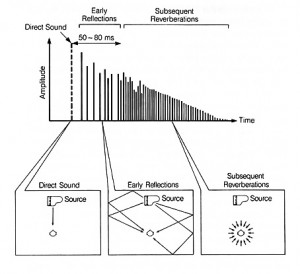UK based Audio Designer Samuel Justice has posted an interesting blog post discussing the importance of early reflections in recreating authentic sounding 3D environments. An excerpt of his article is below, and you can read the full article, with audio examples here
Game audio is at an exciting turning point these days, not only do game makers realise the full potential of engaging immersive audio (and the negative effect of a product lacking in this) but us sound designers are now given the responsibility and freedom to create an entire audible world with as much creativity as we can muster (within the given time frame).
The recent generation (and history) of games is a testament to how the industry is home to some of the most creative sound designers around, you only have to listen to their work and you are instantly transported to another world, created entirely by their vision and expertise. Game audio engines are as well more powerful then ever, talented audio programmers have been able to model occlusion, diffusion, diffraction and a whole other slew of wonderful processing effects that help players immerse themselves into the worlds we create.
But this article is not about praising sound design, or sound designers. Instead, what I hope to achieve is to bring about the importance of a major feature that is missing from a lot of game audio engines, or is not being used. It is one of the pinnacle processing effects (in my opinion) that glues audio into the environment and allows it to blend in naturally, thus, not breaking the all important immersion.
I’m talking about early reflections.

Really enjoyed reading Samuel’s article, great find! It’s always a challenge to make a realistic acoustic environment, not only for video games but for film as well, and I for one just at this information up as I’ve never thought so much about how early reflections make up a large part of a sound’s “grounding to reality”. Thanks for sharing!